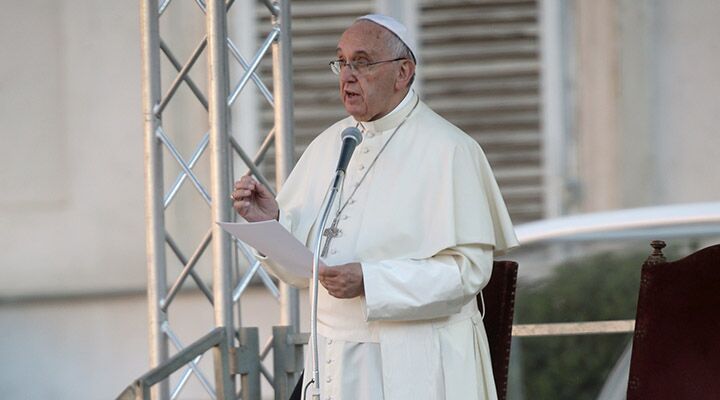
Pope Asks: ‘Why Didn’t Allied Powers Bomb Railroads to Auschwitz?’
During his trip to Turin, Italy, on Sunday, Pope Francis made some impromptu remarks to a group of young people. Several of his statements seemed designed to feed the cynicism toward authority often present in young minds.
In today’s world, “Everything is done for money,” the pope lamented.
Decrying the foreign policy of leading nations in the 1930s and 1940s, Francis said: “The great powers divided up Europe like a cake.”
And then came the bombshell:
“The great powers [in World War ii] had photographs of the railway routes that the trains took to the concentration camps, like Auschwitz, to kill the Jews, and also the Christians, and also the Roma, also the homosexuals. Tell me, why didn’t they bomb those railroad routes?”
This is brazen condemnation of the United States and Britain in particular. It implies that they knowingly, perhaps unfeelingly allowed Nazi slaughterhouses to operate at full steam when they could have easily stopped it.
On the surface, this question might sound like the harmless musings of an ill-informed armchair general. But, not only is it oblivious to key facts of World War ii history, it also represents a dark hypocrisy.
Why Not Bomb Them?
Historians and military strategists agree on some key reasons why the Allied powers didn’t bomb the railroad routes leading to Auschwitz.
First, Allied powers didn’t recognize the full extent of atrocities happening in the camps. They knew of the camps, but the prevailing view—until the latter chapters of the war—was that the purpose of them was for slave labor and hostages.
Operating under the assumption that they were labor camps, the Allies believed that cutting lines to them would result in killing not fewer people, but more.
Hindsight is 20/20. But in the thick of the largest and most destructive war in mankind’s history, and through a fog of hatred that defies logic, vision was obscured and motives misinterpreted.
Second, during World War ii, bombing to destroy individual rail lines was not a practical goal. Rails are thin slivers of infrastructure, just a few feet wide. The accuracy of bombers was so poor that hundreds of planes and thousands of men would have been required to strike one specific rail line. And all precision bombing had to be done in daylight. Additionally, until very late in the war, the range of Allied fighter escorts did not extend into Eastern Europe, where most death camps were located.
Third, German forces were generally able to repair bombed rails in days or even hours. In Engines of War, Christian Wolmar discusses the resilience of German railroads and shows that when the Allies targeted them, disruptions to rail traffic were minimal. “[H]uge resources of manpower, including prisoners and forced slave labor, were thrown at the repair work,” he wrote. “At Hamm [Germany], for example, which suffered more than 1,300 hits in a raid on the night of 22 April 1944, … 6,000 workers were commandeered almost immediately. A through-track was restored within 24 hours of the attack, and by the end of six weeks … the yard … was working almost to full capacity.”
Besides viaducts and bridges, railroads are essentially mounds of dirt and rock with some wood and steel on top. Since low-tech solutions could rapidly repair them, bombing rail lines would have been a short-sighted strategy for the Allies to adopt.
The Allies were perfect neither in military strategy nor in morality, but they fought against the evil that was fueling the Holocaust. They sacrificed millions of soldiers’ lives to bring an end to that evil.
What about the Vatican? Did the Vatican throw its great weight behind trying to halt that evil, or was it complicit in it?
Another Set of Questions
If Pope Francis were truly interested in exposing the skeletons in World War ii’s closet, he would be asking a different set of questions, such as these:
The pope is eager to question the actions of others, but apparently unwilling to judge the actions of his own church. As amazing as his selective memory is in this situation, it is not atypical for the Vatican. A willingness to overlook dark chapters of its history—and to sometimes even try covering them up—is business as usual for the Roman Catholic Church.
As Pope Francis increasingly injects himself into modern politics, and as the Vatican becomes increasingly influential in current affairs, it is more vital than ever to understand the details of the Catholic Church’s long history—and its shocking future.
To gain that vital understanding, and to learn what it means for you and your loved ones, you need our newest booklet, The Holy Roman Empire in Prophecy. The booklet will be available in September, but you can pre-order your free copy today.
